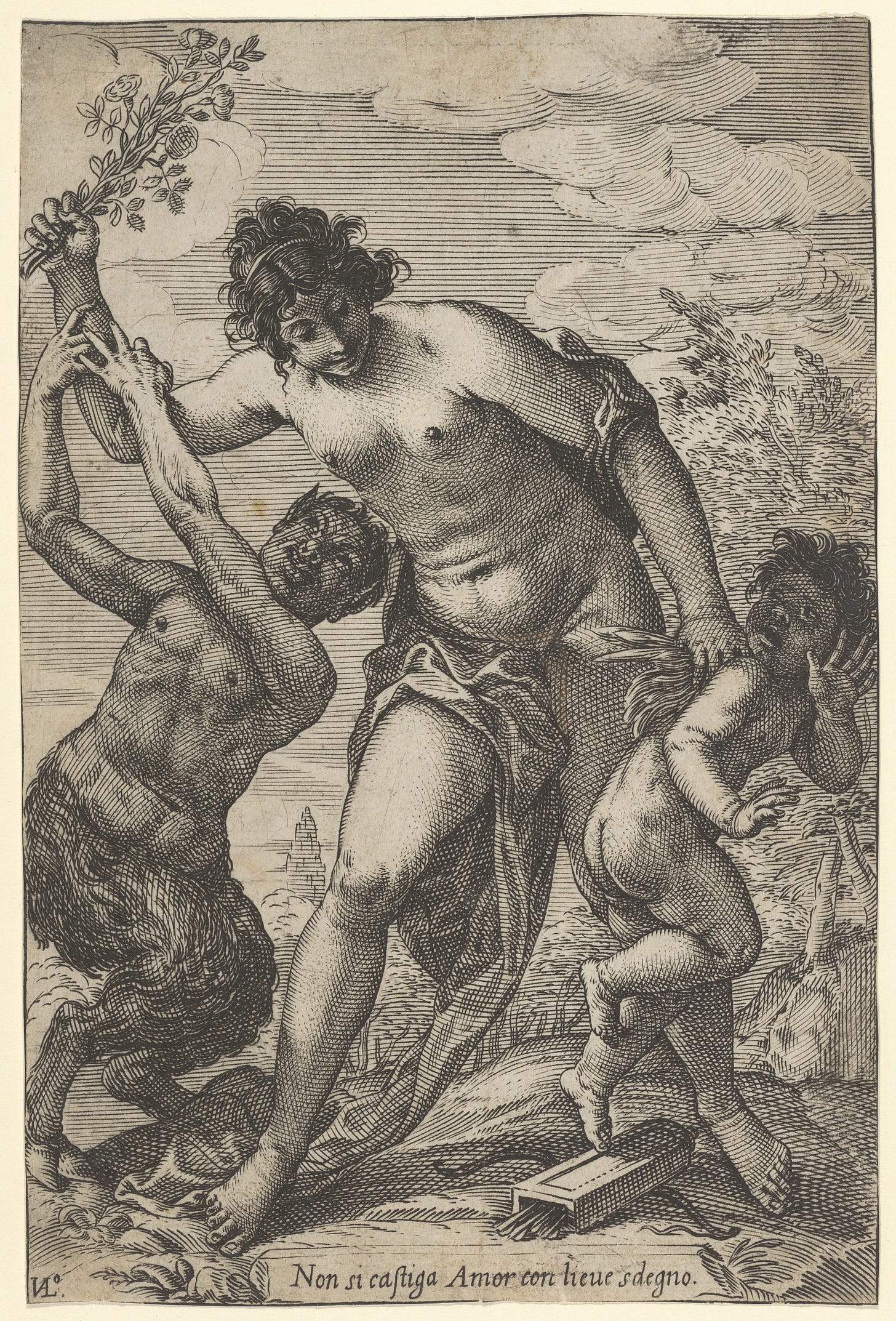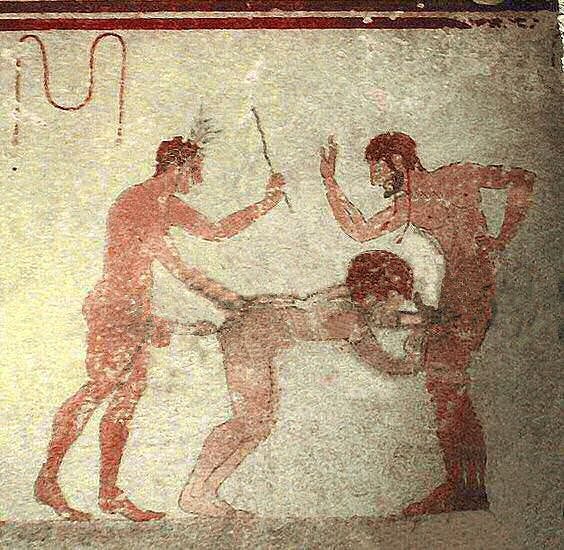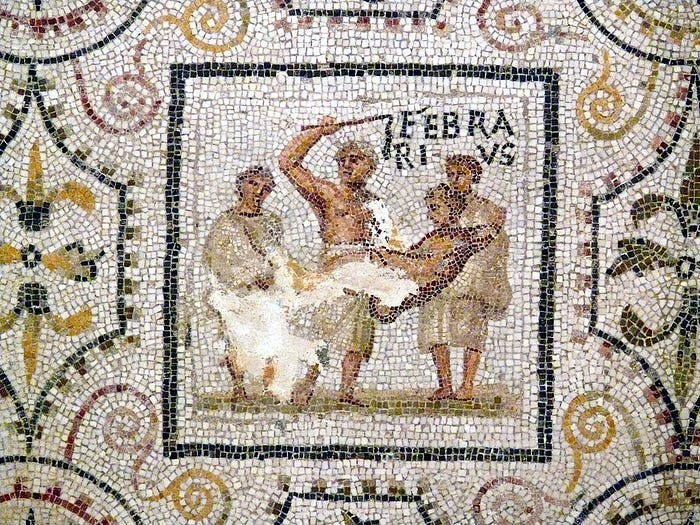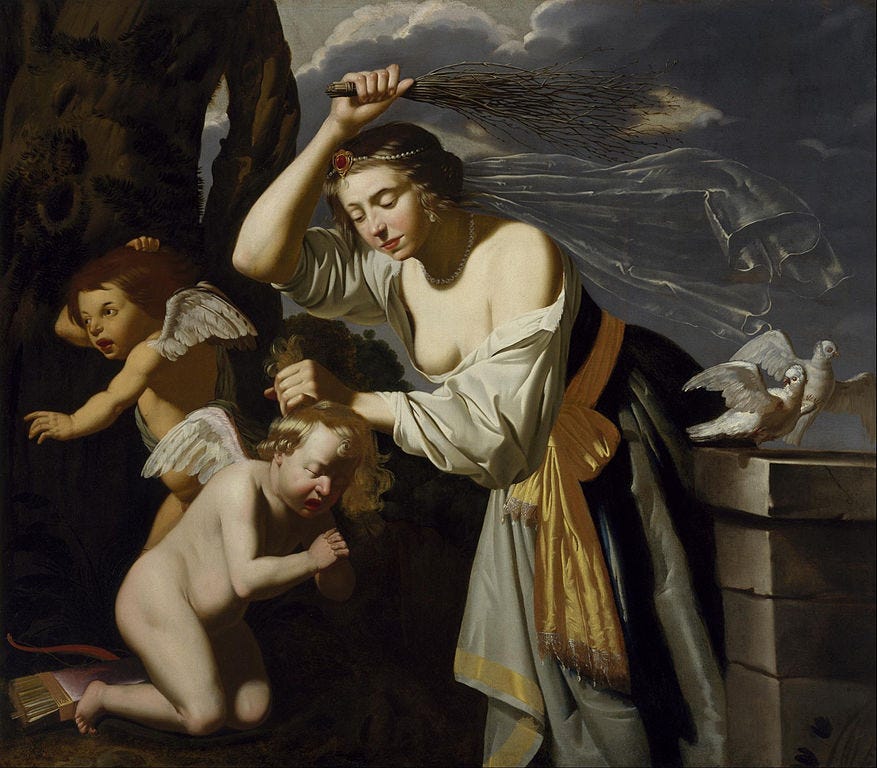
Wait, why is Venus spanking Cupid?
The caption of this marvellous image is in Italian, and reads: “Non si castiga Amor con lieve sdegno”, which can be translated as: “Lust cannot be subdued with mere disdain”.
This 17th century image by Giovanni Luigi Valesio is packed with symbolism and subtle meanings. Even his use of the word “castiga” - literally, to be be punished - implies a struggle for control and dominance. It suggests that love is a primal force, as ancient as the Gods, which resists our mortal attempts to master it and bring it under our control.
Venus is, of course, the Goddess of Love and Beauty. Her act of whipping Cupid signifies a desire for control, which can even be punitive. A reflection that sometimes love is not all gentle sweetness. Sometimes love can be forceful, demanding, and even painful.
Cupid is the mischievous God of Desire and Lust, and is the son of Venus. He is often depicted as a winged boy wielding a bow and arrow. Just like all boys, lust and desire can be chaotic, unruly, and tempestuous. So the word ‘Amor’ in the caption is a pun, since in Italian it refers to both the general concept of love, and the personification of lust that we English speakers call Cupid.
Venus and Cupid represent the dichotomy of love, the former stable and romantic, the later a disruptive force of nature that’s not easily controlled. The whipping of Cupid suggests a complex struggle between love and desire that’s as old as humanity itself.
The image does not show Venus lecturing Cupid, but flogging him, perhaps alluding to the notion that the urge to discipline those we love is part of our psyche. Yet the means of discipline chosen isn’t a whip, but a bunch of roses. There is a message here, in art roses symbolise love and beauty, but in this context their thorns hint at the pain that’s an inseparable part of loving.
There is a third character present too, a Faun, who adds another layer of symbolism to this fascinating image. Fauns are creatures from classical mythology, typically depicted as half-man/half-goat with pointed ears, a tail, and sometimes horns. They are associated with nature, sensuality, and wildness. Artists have historically used them to symbolise unrestrained lust and carnal desires. Their presence suggests a more animalistic, primal side to love.
The faun in the image seems to be trying to influence the whipping, by restraining the arm of Venus. One might interpret this image as a symbolic struggle, with Venus attempting to control desire, whilst the faun wants to ensure that the lust is not completely subdued, and the crucial imperative of desire is still allowed the opportunity to flourish.
In other words, in trying to restrain Venus's attempt to discipline Cupid, the faun is representing the raw, untamed forces of lust and desire that often defy control. It suggests that love has two sides, the orderly enduring love of affection, and the raw, instinctive desires that can be difficult to tame. The faun is included to remind us that love has a darker, more primal force, and it would be unwise to try to subdue it completely.
Interestingly, Valesio wasn’t the only 17th century artist to paint Venus whipping Cupid. Jan van Bijlert painted the same setting too:
This depiction seems to have a subtly different message. Here Venus is chastising Cupid with a rose switch. It seems more like a punishment, retribution for the Cupid’s indecent sins, his quiver and bow lie discarded on the ground, symbolising his submission. There is no doubt who is dominant here.
There is no faun in this painting, no advocate for wild primal side of human nature. The orderly motherly love of Venus has primacy, and is expected to be obeyed. Perhaps this is a reflection of the social mores of the Netherlands in the 1620s, when the ascendency of Calvinism meant virtue and modesty were promoted, and sexuality was expected to remain behind closed doors.
Two decades earlier, in catholic Italy, Valesio was saying, lust can not be subdued by mere disdain. Renaissance humanism did see a renewed interest in the physical and emotional aspects of love. I wonder if that disdain was also painted by Jan van Bijlert years later, reflecting the conservative attitudes to sex espoused by puritan protestants.
Both paintings are grounded in the social and cultural context of the 17th century. It was a time when talking openly about sex was still difficult, but it was becoming more socially acceptable for artists to discuss aspects of love, sexuality, and morality in their art, albeit coded within allegories and metaphors.
Artists know we are instinctively attuned to recognise power dynamics, we can rapidly assess who is dominant and who is submissive. Whippings are dramatic, floggings make us want to stop and watch. They make great pictures.
There’s an irony in strictness, when we’re told not to do something, that only makes it more alluring. Hence the artist’s mischievous caption: lust is not so easily dismissed.
We human beings have always wanted to express what arouses us in our art, and this is a desire that goes back a long, long way.
February’s Kinky Secret
In 1960, a tomb was uncovered in central Italy, which came to be known as the Tomb of the Whipping, on account of the following erotic fresco on its walls:

This image has been dated to approximately 490 BC, meaning it’s over 2,500 years old. We might think being kinky is a relatively modern invention, the product of successive generations of sexual permissiveness. But this image reveals there’s nothing new about the desire to spank - or be spanked.
Did you know that long before the modern world chose Valentine’s Day as its designated day of love, there was an ancient Roman festival called Lupercalia?
Did you know that it began on the Ides (the 13th) and climaxed on the 15th of February, and consisted of purification and fertility rites that held such significance in the Roman calendar that the month of Februarius was named after them?
You might already know January is named after Janus - the Roman god of doorways -since the Latin word for door is ianua, and January is the entrance to the year. March is named after Mars, the Roman God of War (and father of Cupid), as the beginning of Spring marked the start of the military campaigning season. But what about February?
It may surprise you to learn that February does not honour a God. Instead it was named after the Roman purification ritual of Februa, an ancient rite which was later subsumed by the purging and fertility festival of Lupercalia.
The 1st century historian Plutarch described Lupercalia like this:
“At this time many of the noble youths and of the magistrates run up and down through the city naked, for sport and laughter striking those they meet with shaggy thongs. And many women of rank also purposely get in their way, and like children at school present their hands to be struck, believing that the pregnant will thus be helped in delivery, and the barren to pregnancy.”
These thongs, leather whips cut from sacrificed goats, were also called Februa. Look at the central figure in this mosaic depicting the Roman month of Februarius, and you can’t miss the whip.

In other words, the roots of February’s name are in an ancient naked whipping festival. Isn’t it funny how countless millions around the world will write the word February this month, and never wonder about its origins. The kinky secret hidden by the ancients in plain sight.
Although Lupercalia was a fertility rite, scholars believe its proximity to the contemporary St Valentine’s Day is purely coincidental. But over the centuries, the twin personifications of love: Venus and Cupid, romance and lust, have continued to linger in our collective consciousness. Their symbolism has since appeared in countless works of art.
That’s why Venus is spanking Cupid in a 17th century Italian engraving. It seems the echoes of half-remembered rituals were still reverberating, even two millennia later.
So if you have someone special in your life, you are blessed. Tell them how much you love them, then show just how much, by baring their bottom and spanking them pink. Send them this post, and tell them to be waiting ready for a good spanking when they get home.
And instead of buying flowers and chocolates, you should really buy your lover a flogger. A little whip perhaps, or some slippers, or a cane. Maybe even a hairbrush, you could even personalise it.
You’ll be reviving a tradition that goes back over 2000 years. That spanking is love. That a warm bottom inspires a contented heart.
Because lust cannot be subdued with mere disdain.
Such is the wisdom of the ancients.






Splendid thoughts on Love, Lust and Passion. This engraving is incredible ( better than the painting.)
Poor little Cupid! Though I expect he usually gets his own way... It was a lovely read - thank you!